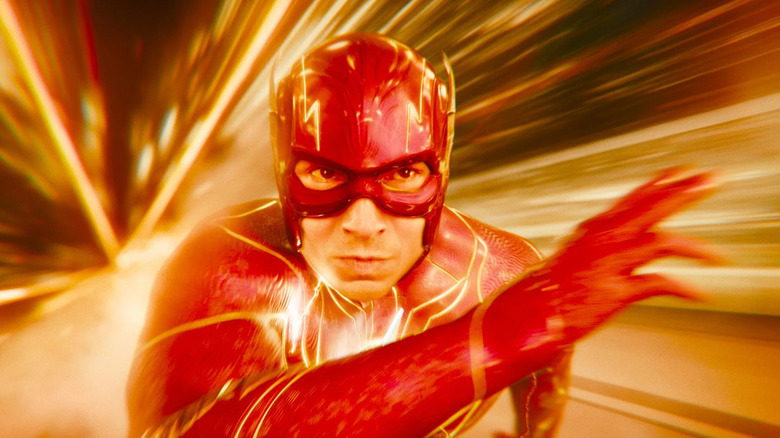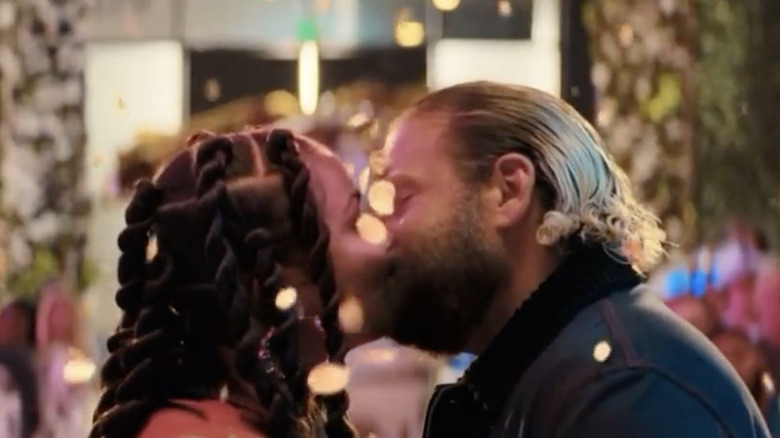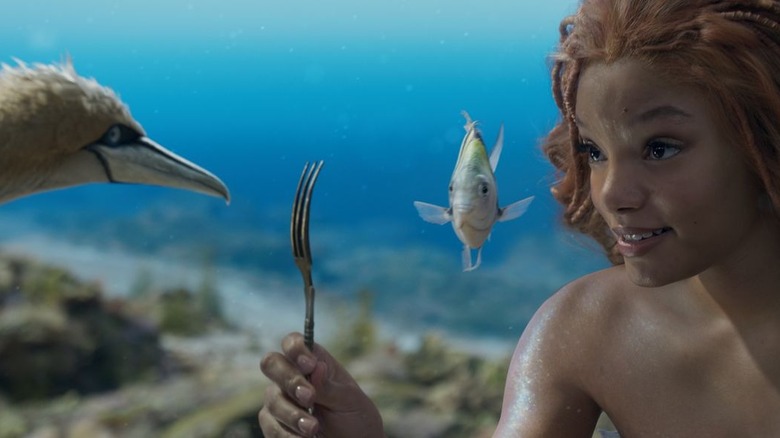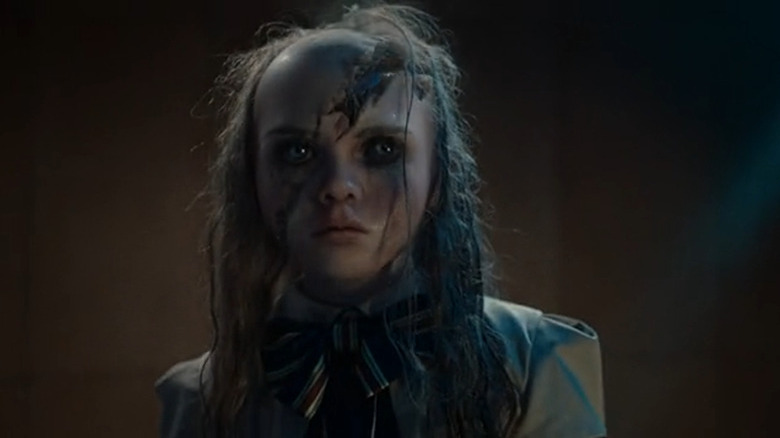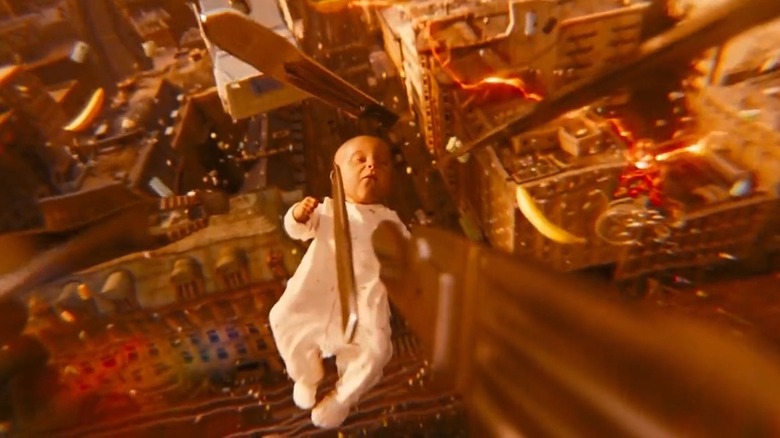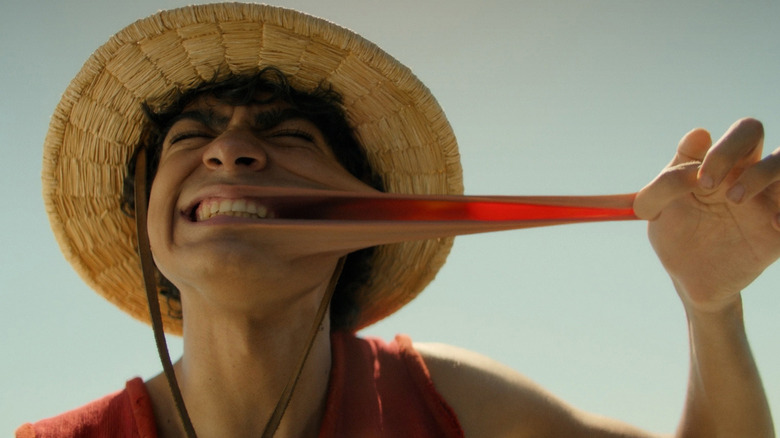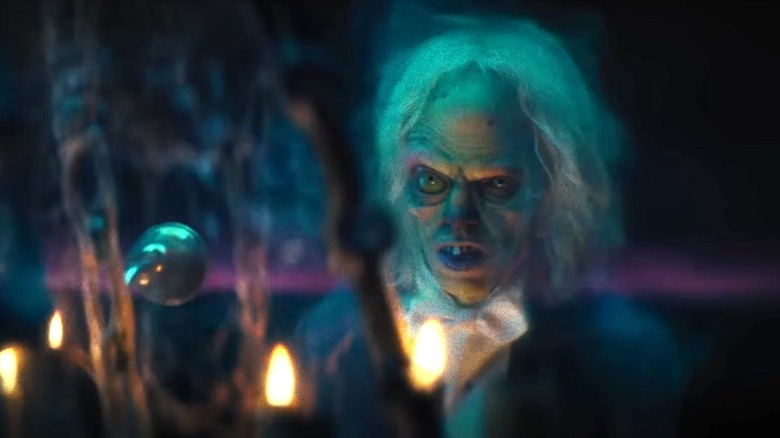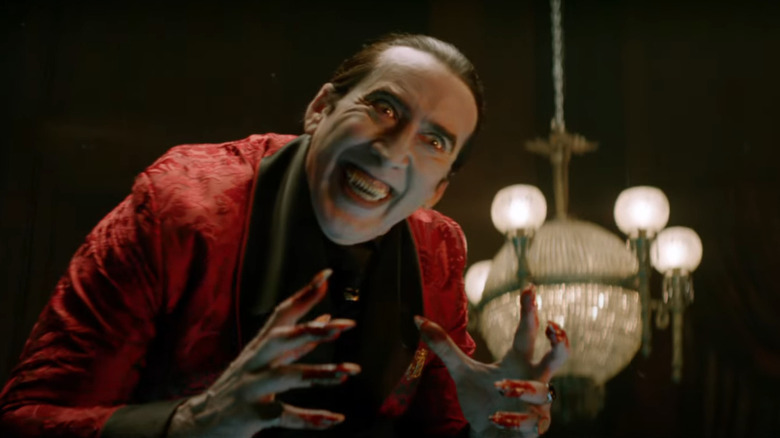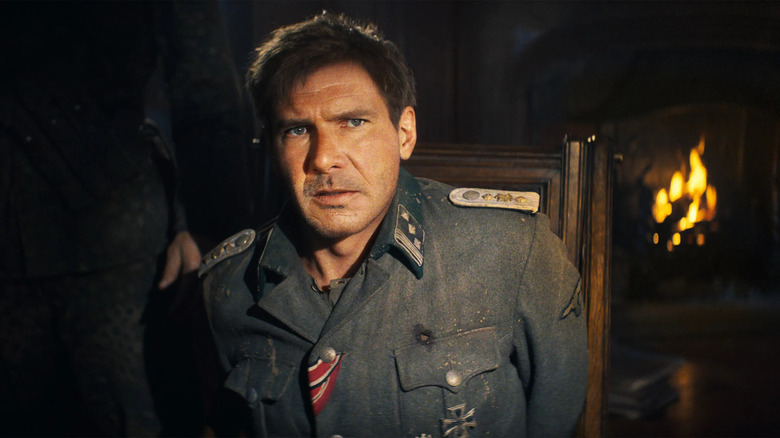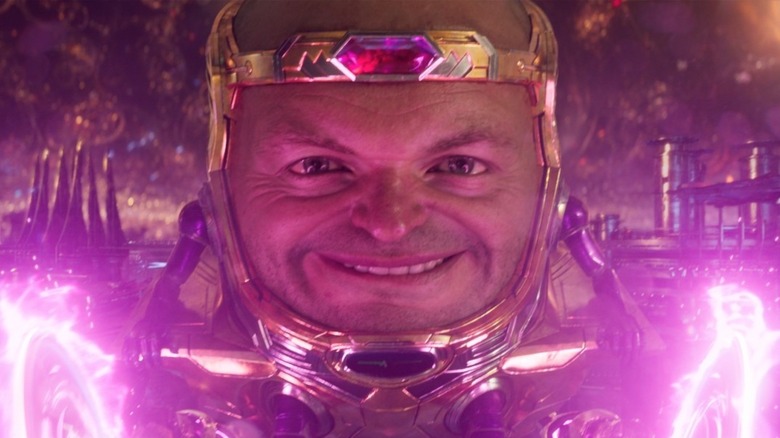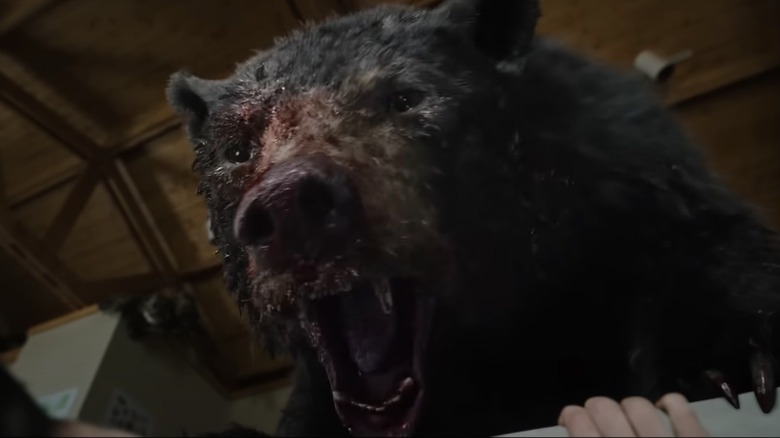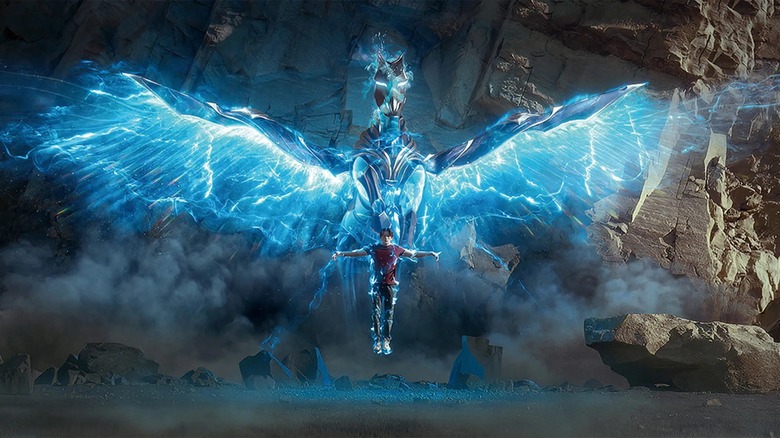The Worst Special Effects Of 2023 So Far
When it comes to films, especially big-budget blockbusters, one of the most valuable tools in their arsenal is the special effects team. While the effects, be they digital or practical, merely gild the narrative, they are arguably the most important enhancements at a filmmaker's disposal.
With the right artists and enough clever use of the film's budget, special effects can transport the viewer to another world. Sadly, not every film can have CGI like "Avatar: The Way of Water," with many others featuring cheap, outdated, and schlocky special effects. 2023 has seen some especially horrendous examples, a few of which have escaped their respective films to attain meme status online.
Now, to clarify, just because the special effects might fall flat doesn't mean all of the films on this list are necessarily terrible. We only mean to elaborate on why their special effects might've dipped in quality part way through, or simply never stood a chance at all. With all that said, get ready to laugh as Hollywood throws money into a belt sander — here are the worst special effects of 2023 so far.
You People
You wouldn't think that a romantic comedy would be the venue for botched CGI, but "You People" certainly proved otherwise. The film follows Ezra Cohen (Jonah Hill) and Amira Mohammed (Lauren London), a white Jewish man and a Black woman who enter into an interracial relationship, leading to a culture clash between their families.
Needless to say, it's an uncomfortable situation, especially when Ezra's mother, Shelley (Julia Louis-Dreyfus), and Amira's father, Akbar (Eddie Murphy), get involved. The film eventually leads to the always-predictable trope of the second-act breakup, leaving the audience to twiddle their thumbs until Ezra and Amira get back together. They, of course, do, and after being surprised by their parents with an impromptu wedding, share a tender kiss after tying the knot. However, if something seems off to you about Ezra and Amira's kiss, that's because it was done with CGI, and it looks positively ridiculous. The best way we can describe it is as if a small wormhole opened up between their lips, sucking them both into oblivion.
Per the LA Times, this was due to the film being made during COVID-19, which meant an actual on-screen kiss couldn't be shot. It's an understandable yet still baffling decision that spoils what could have been a genuinely heartwarming moment.
The Little Mermaid
Whether we like it or not, Disney seems determined to remake all of their 2D animated classics into flashy live-action movies. This has been the case for "Aladdin," "The Lion King," "Beauty and the Beast," "Dumbo," and most recently "The Little Mermaid." The film already amassed racist controversy due to the casting choice of Halle Bailey as Princess Ariel, the titular mermaid.
However, following the film's release, fans had a more reasonable criticism of the film: The questionable quality of its visuals. None of the original film's hand-drawn charm is on display here, its brightly colored ebullience traded in for a literal sea of murky CGI. In the animated version, Ariel's iconic red hair pops against the ocean background, enhanced with little touches like radiant light and small bubbles everywhere. Now, poor Halle Bailey, who is carrying most of the film on her shoulders, looks as if she's slogging her way through a murky and low-lit soup.
The CGI does very little for her underwater sidekicks as well, with Flounder and Sebastian looking less adorable and more like unspeakable eldritch horrors. Needless to say, if Disney was hoping to recapture the same magic as the 1993 film, they fell somewhat short of the mark.
M3GAN
"M3GAN" was an unexpected box office hit and a solid reminder of just how entertaining horror-comedies can be. The film introduces M3GAN, a highly sophisticated doll imbued with artificial intelligence, created by Gemma (Allison Williams), a roboticist working at a fictional toy company. However, while M3GAN's main purpose is to serve as a protective companion to Cady (Violet McGraw), Gemma's recently-orphaned niece, she soon begins to pursue a more sinister agenda.
The bodies begin piling up at record speed as M3GAN goes on a rampage, destroying school bullies, nosy neighbors, and even a dog. Impressively, most of M3GAN's onscreen carnage is achieved with practical effects, the most impressive being M3GAN's uncanny valley-infused facial features and still robotic movements. However, the keywords there are "most of," meaning there are a fair amount of computer-generated enhancements. This includes some noticeable CGI blood, as well as some moments where M3GAN herself — most notably her face — is computer generated.
In the film's finale, a genuinely entertaining sequence, M3GAN goes from being a practical effect to mostly CGI, and it's definitely more distracting than intended. The human eye is always going to catch when a real physical element — for example, a face — is suddenly transitioned into being rendered digitally. It's a less-than-desirable addition to a film that, up until that point, had done a better job integrating different special effects styles.
The Flash
Well, to be perfectly honest, we were always going to arrive here at some point. From its problematic cast to its disappointing box office gross, everything about "The Flash" has been a disaster to some degree. This includes the CGI which, to put it charitably, would feel more at home on an original XBOX console plugged into a CRT television set.
There's, of course, the horrifying moment where Barry (Ezra Miller) saves a veritable downpour of creepy CGI babies, all falling in the debris of an exploding hospital. Then there is the succession of poorly rendered cameos featured in the film's multiverse sequence, including George and Christopher Reeve's respective Supermen and Adam West's Batman. There's also a horrendous-looking CGI double of Nicholas Cage, used to portray the Man of Steel as he would've looked in the canceled "Superman Lives."
However, even effects as simple as Barry zipping through Flashtime (his perception of super speed) look like something you'd see on a later season of CW's "The Flash," done to greater effect with a much smaller budget. We feel comfortable saying that a $200 million blockbuster shouldn't be visually on par with something shown on cable TV.
One Piece
In another edition of "Why did this need to be live-action?" we have Netflix's latest anime adaptation with "One Piece." Based on the long-running smash hit manga, the tale of Monkey D. Luffy and the Straw Hat Pirates has been entertaining fans since the late '90s.
So needless to say, when a live-action adaptation was announced by Netflix, many fans went into emergency panic mode. Anime being translated into live-action hasn't usually delivered stellar results, with critical failures such as "Dragonball Evolution" and Netflix's "Death Note." Things didn't improve much when the first few trailers dropped and we got our first look at Luffy's Devil Fruit powers in action.
Regardless of how Iñaki Godoy does with the role of Luffy, there's no denying that seeing a human being stretch like rubber is the stuff of nightmares. In the manga and anime, the absurdity of Luffy's Gum Gum powers was always a major highlight, with the captain of the Straw Hats continually developing new fighting techniques. It helps that in illustrations and animation, Luffy's proportions and facial features could be exaggerated as much as needed for a particular scene. Here though, it genuinely looks like Godoy fell into a nuclear test site and was cursed with horrific stretching abilities. It's another prime example of something that loses its charm and becomes terrifying upon being translated from 2D to 3D.
The Haunted Mansion
In a summer movie season rife with box office bombs, few fell flatter than Disney's poorly received "Haunted Mansion" reboot. Whether it stars Eddie Murphy or LaKeith Stanfield, it seems as though the House of Mouse can't translate one of their most beloved rides into a movie.
It's honestly a shame because, alongside "Pirates of the Caribbean," the original "Haunted Mansion" ride is loaded with cinematic potential. From its eerie yet vibrant setting to its cavalcade of creative spooks and specters, the ride is a perfect blend of kid-friendly energy and old-school spookiness. So you'd think that with a $157 million dollar budget, the ghosts would look a bit better than something you'd see in the 2016 "Ghostbusters" reboot. While it does make sense for ghosts to be rendered in CGI, as they are meant to be inhuman, there's very little in terms of anything tangible. These are allegedly terrifying ghosts after all — if they don't exude some level of menace, then what's even the point?
The film, in fairness, is meant more for children and families, but that shouldn't have stopped Dinsey from putting a bit more effort into the ghosts themselves. If the haunted element of the titular "Haunted Mansion" is dead on arrival, it shouldn't be shocking that the rest of the film is too.
Renfield
"Renfield" is an interesting blend of elements, resulting in an uneven yet still entertaining horror-comedy production. The film sees the titular Renfield (Nicholas Hoult) look to end his multiple-century-long service to the infamous Count Dracula (Nicolas Cage).
This is a frustrating one because, for the most part, "Renfield" does boast some impressive special effects, especially when it comes to Dracula himself. The Count has a few different looks throughout the film, including his dapper-looking main form and a few rotting variants, all achieved through some stellar prosthetics. However, these effects only make up a comparatively small percentage of the film, with the rest dominated by some clunky-looking CGI.
This includes Renfield's powers which, to be polite, seem more on par with something you'd see in "Power Rangers" more than a modern horror-comedy. Then there's the copious amount of CGI blood which, when used alongside actual practical effects, stands out even more like a sore thumb. A perfect example of this is an explosion of blood which looks like barely rendered Playstation graphics.
Indiana Jones and the Dial of Destiny
It's always a shame when a once-mighty franchise falls flat on its face, as is the case with the "Indiana Jones" series. Whether he's uncovering aliens or dabbling with time travel, the good Dr. Jones really lost a step following the turn of the century.
"Indiana Jones and the Dial of Destiny" is yet another example of a beloved pop culture icon being trotted out again to prey on the audience's nostalgia for the original "Indiana Jones" movies, which all had amazing special effects, especially at the time they were made. Who could forget such iconic moments as Indy outrunning the giant boulder in "Raiders of the Lost Ark," or the mine cart chase from the "Temple of Doom" climax?
Sadly, "Dial of Destiny" provides very little in the way of tangible special effects, with most of its enhancements being of the CGI variety. It's fitting that this entry dropped the same summer as "The Little Mermaid" and "The Haunted Mansion," as the effects are basically on the same level. In many key action sequences, the characters and environments seem more like something you'd see in a fully animated movie. When compared to the highs of the previous films, these special effects truly fall short of the mark. If Indy is truly meant to ride again, as the post-credits scene suggests, then we can only hope the effects will be given a serious overhaul next time.
Ant-Man and the Wasp: Quantumania
One of the bigger criticisms levied against Marvel during Phase 4 of its cinematic universe has been directed toward the CGI effects used in its movies and streaming shows. As these projects roll off of Disney's assembly line with seemingly less care, it's been hard not to notice a decline in their visual quality.
This was on full display in one of Marvel's last cinematic outings, "Ant-Man and the Wasp: Quantumania." The third film in the "Ant-Man" trilogy is a far cry from the best the MCU has to offer, and the Rotten Tomatoes score certainly reflects that. Not even a solid performance from Paul Rudd could save this poorly written mess of a film.
However, aside from some narrative issues, the biggest issue with the film for many fans was the CGI, with one specific instance on their minds. That would be the first live-action appearance of the villain M.O.D.O.K, played here by Corey Stoll, reprising his role as Darren Cross from the first film. Needless to say, some characters were only ever meant to be portrayed in still drawings or via animation, and M.O.D.O.K is a prime example. Just look at the poorly rendered head, the unflinching eyes, and that gaping maw of a mouth — it's nothing short of a digital dumpster fire. If Marvel wants to right the ship in Phase 5, they had better avoid another visual misfire like this one.
Cocaine Bear
Aside from the recent Barbenheimer phenomenon, one of 2023's most meme-worthy movies is "Cocaine Bear." Very loosely based on true events, the film tells the absurd story of a grizzly bear going on a rampage after eating cocaine that was air-dropped into the forest. This results in ample bloodshed with the bear tearing apart just about anyone or anything that's unfortunate enough to cross its path.
It's just a shame that the titular bear isn't the most convincing movie monster, rendered instead with some fairly subpar CGI. Now, of course, it makes sense to use CGI when an animal is involved, especially in a film as crazy as this one. No director or studio would want to ever actually use a real animal for any of the actions required in this film, even if there was a way to do so using practical effects.
However, with all of that said, there are several instances where the bear simply doesn't look anywhere close to real. Instead, it moves far too fast and cartoonishly to ever be taken seriously as a tangible onscreen menace. There is a scene where it chases after an ambulance that looks particularly cheesy, especially when you focus exclusively on the bear itself.
Knights of the Zodiac
If this is your first time hearing about "Knights of the Zodiac," don't feel bad: The film wasn't even a box office hit in its country of origin. Released out of Japan, "Knights of the Zodiac" is an action-fantasy film directed by Tomek Bagiński. Based on the "Saint Seiya" anime series, the film follows a loose translation of the story, focusing on an orphan named Seiya who discovers his true destiny. This includes his mystical superpowers as well as the introduction of a reincarnated goddess who he must now protect with his life.
With such a fantastical premise, you'd expect some equally fantastical special effects to accompany it. However, much like many other anime to live-action adaptations, what works in 2D animation doesn't translate to the silver screen with any ease. The swift fantasy visuals of the anime — and even the manga — are completely absent here, replaced instead with graphics more befitting a low-budget cable show. With all the nauseating colors and less-than-convincing textures, the film shares a distressing visual connection to "Dragonball Evolution," another film that the anime fandom wishes could be erased from existence.
